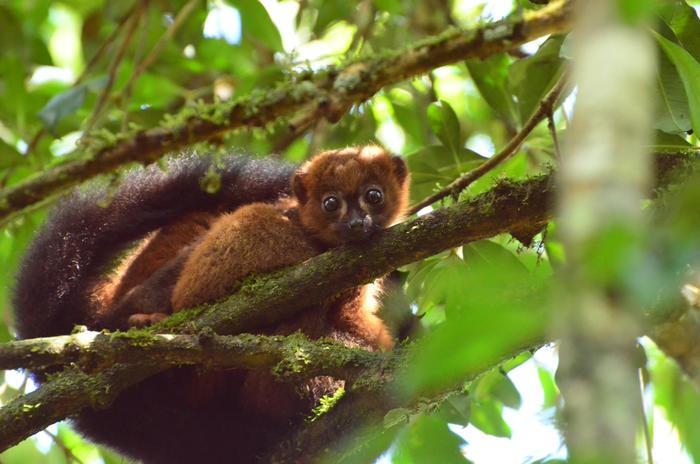
Conservation efforts directed in direction of simply 0.7% of the world’s land mass might assist defend one third of the world’s threatened and distinctive tetrapod (four-limbed vertebrate) species, new analysis by Imperial Faculty London, On the Edge, and ZSL seems to indicate.
The examine, led by researchers at Imperial Faculty London and printed in early September in Nature Communications, finds that giant positive aspects in conservation are doable by specializing in areas house to distinctive biodiversity and species with excessive ranges of evolutionary distinctiveness and international endangerment.
These endangered species embody animals just like the aye-aye, a extremely distinctive lemur present in Madagascar; the long-legged and eagle-bodied secretary fowl; the purple frog, which has a nostril much like a pig; and the gharial, a long-snouted and critically endangered crocodile discovered within the Indian subcontinent.
At current, nonetheless, simply 20% of the areas recognized within the examine are below some type of safety, with most areas dealing with constant and growing ranges of human strain.
Lead writer Sebastian Pipins, a PhD candidate on the Grantham Institute, Imperial Faculty London, mentioned: “Our research highlights the regions of the world that are of immediate concern. Furthermore, it shows that in protecting just a fraction of the Earth’s land surface, huge gains can be made for the preservation of nature.”
On the sting of extinction
The undertaking recognized particular areas of conservation curiosity with exceedingly excessive ranges of threatened evolutionarily historical past which are marked by their focus of Evolutionarily Distinct (ED) and Globally Endangered (GE) species.
Evolutionary distinctiveness quantifies how distinctive a species is, with some being the results of lengthy durations of distinctive evolutionary historical past with few or no shut dwelling kin. In the meantime, international endangerment displays the extinction danger of a species. Species that rating extremely on each measures are often known as EDGE species, whereas the areas during which these species are present in excessive concentrations are known as EDGE Zones.
Pipins added: “It is crucial to not just consider species diversity in conservation efforts, but also the evolutionary history of diversity, to ensure that large and unique branches from the tree of life are not lost.”
Zones of curiosity
The examine mapped the distribution of just about 3,000 EDGE species, figuring out 25 EDGE Zones the place conservation efforts can have the best affect.
Particular areas of EDGE species richness embody giant components of Southeast Asia and the Indo-Gangetic plain, the Amazon basin and the Atlantic Forest, in addition to in Hispaniola, the highlands of Cameroon, and the Japanese Arc mountains of East Africa.
The authors discovered most richness inside an space of lower than 100-square kilometres in Madagascar, which, together with Mexico and Indonesia, contained the best variety of EDGE species.
Underlining the vital significance of nationwide management to help conservation efforts, the analysis additionally discovered that 75.6% of EDGE species exist inside a single nation.
Co-author Dr Rikki Gumbs, from the ZSL’s EDGE of Existence programme, mentioned: “Three-quarters of the world’s most unique animals are able to call only one country home, meaning that action from individual nations will go a long way to protect these incredible species from extinction.”
Very giant areas of Southeast Asia have greater ranges of EDGE species, which the researchers say displays how the looming biodiversity catastrophe on this area is impacting the extremely distinctive and wide-ranging species discovered inside.
Human elements
The scientists additionally discovered that the overwhelming majority of EDGE Zones face excessive ranges of human disturbance and that the human populations discovered inside many EDGE Zone nations face deprivation in training, well being, and dwelling requirements.
Dr Gumbs added: “We’re currently in the midst of a biodiversity crisis, driven by unsustainable use of natural resources; it’s shocking but not surprising that 80% of the zones we identified are under high levels of pressure from human activity.”.
Given these challenges, governments’ restricted sources are sometimes prioritised for coping with human deprivation, leaving much less for biodiversity conservation.
Pipins mentioned: “Given the global importance of the biodiversity found within these regions, high-income countries must mobilise funding to facilitate sustainable development that can benefit both humans and nature.”
World objectives
Simply 20% of EDGE zones are below some type of safety. As nations look to guard 30% of land and sea by 2030, as per the Conference on Organic Range’s goal, the authors name for the unprotected parts of EDGE Zones to be prioritised.
Dr Gumbs mentioned: “With the COP16 Biodiversity Conference on the horizon, we need to see world leaders from across the globe scaling up their commitments and resources to support these efforts and restore the natural world that we all rely on.”
The researchers argue that their findings display that giant positive aspects of biodiversity are doable with comparatively small additions to globally protected areas. In addition they argue that their analysis provides the potential for extending the EDGE Zone strategy to different necessary teams of wildlife, similar to vegetation and fish.
Utilizing EDGE zone analysis
The EDGE Zones recognized on this analysis will information the actions of the charitable organisation On the Edge, directing their conservation grant-making, regional campaigns, and grantee-led storytelling.
They may even type a part of the decision-making for useful resource allocation for ZSL’s EDGE of Existence programme, which has already funded work on over 50 EDGE species discovered inside EDGE Zone nations, with a selected deal with the Gangetic Plains and Cameroon.